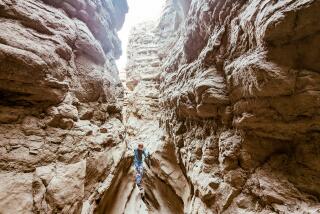Taking a Look at the Course, by the Numbers
- Share via
RANCHO SANTA MARGARITA — Here’s a look at the Tijeras Creek golf course, with a few tips on how to avoid some trouble and maybe even shave a few strokes off your round (all distances from blue tees):
No. 1 (507-yard par five)--Dogleg left. A fair opening hole with a wide-open landing zone for the drive. Fairway bunker on left is about 260 yards from tee. Favor the right on drive and approach shot to green.
No. 2 (346-yard par four)--Short, dogleg left. A birdie hole that can also produce double-bogeys. Use plenty of club on approach to elevated green. A short shot will hit into bank and roll back into deep bunker in front.
No. 3 (442-yard par four)--Straight, long and the No. 1 handicap hole. It requires a long, accurate drive--avoiding four fairway bunkers, two on each side between 220 and 240 yards out--and a long, accurate shot into a two-tiered green.
No. 4 (402-yard par four)--Dogleg right with water on the right. Drive to the middle left. And it’s much better to be short and a little left than long or right (bunker and water) on the approach shot.
No. 5 (162-yard par three)--All carry, over trademark Ted Robinson waterfalls. From slightly elevated tee, this hole looks shorter than it plays. There’s a nice bank in back of the green so long is OK. Short and right are wet.
No. 6 (393-yard par four)--Straight hole, requiring two long shots to get home in regulation. Drive should be a little left. Undulating fairway causes some awkward stances on second shot.
No. 7 (200-yard par three)--With water all along the left side, shooting at the pin from blue tees takes a lot of confidence in your long irons. To the right of the green is a nice landing area that slopes toward the putting surface.
No. 8 (550-yard par five)--Wide-open, fairly straight but long. Favor left on first two shots. One of few greens protected by bunkers in front. Those three pot bunkers and elevated green require plenty of club on approach.
No. 9 (414-yard par four)--Straight, out-of-bounds on right. Barranca across fairway is intimidating but requires only 100 yards of carry. There could be a three-club difference between front and back pin placement on long, sloping green.
No. 10 (342-yard par four)--Dogleg left with water on left. Long fairway bunker saves balls from getting wet. Approach must carry water and pin placement is usually up front. Playing for middle of green is the safest bet.
No. 11 (516-yard par five)--Dogleg right, then left. Hard driving hole, but smart player won’t attempt to cut off right corner. Low-handicapper might get home in two, but landing area for drive is narrow.
No. 12 (342-yard par four)--Slight dogleg left. Aim a little left and swing away. Long drive avoids blind second shot from sloping fairway, which opens up the farther you hit it. Small green calls for precision approach.
No. 13 (519-yard par five)--Dogleg left. Huge, hidden fairway bunker looms on the left so stay right with drive. Left side of fairway also features a series of huge mounds that guarantee awkward stances.
No. 14 (165-yard par three)--A picturesque view down through oak trees from elevated tee. This hole plays longer than it looks and four bunkers circling green make it wise to shoot for middle of the green.
No. 15 (343-yard par four)--Short, slight dogleg left. Narrow stretch in front of tee is intimidating, but fairway opens up after about 140 yards of carry. Precision approach necessary because of three bunkers around small green.
No. 16 (160-yard par three)--Very elevated tee. Another par three that plays longer than it looks, especially in afternoon when undetectable winds swirl over hills. It’s better to be a little long than short, anyway.
No. 17 (399-yard par four)--Dogleg left. Drive to the right of left fairway bunker. Creek and wall in front of two-tiered, elevated green requires at least one extra club on approach. Short shots roll down bank, over wall, into creek.
No. 18 (399-yard par four)--Straight. A good drive can mean a good shot at a birdie. Hidden water on left can come into play on a short hook. Green is long so pin placement might dictate a two-club difference.
More to Read
Go beyond the scoreboard
Get the latest on L.A.'s teams in the daily Sports Report newsletter.
You may occasionally receive promotional content from the Los Angeles Times.










